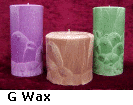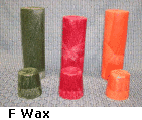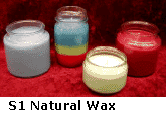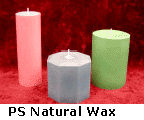Wax 101
It is always an interesting subject, discussing the sources of paraffin wax and the components involved.
Wax in today’s society is a generic term. Wax can cover a broad spectrum of products that include petroleum, animal, vegetable and synthetic based materials. The primary wax used in candles today is refined from petroleum. However, other types of waxes have become extremely popular in the last number of years. These include vegetable or plant based waxes such as soy, palm or bayberry as well as waxes from insects such as beeswax.
This series will focus on various wax types and their applications. With this information, you, the candle maker, will become more knowledgeable about waxes and better equipped to differentiate between them when choosing which wax to purchase.
Basically, paraffin wax is a petroleum product that has gone through a refining process. The end result is a product that is solid at room temperature. Within the refining process, waxes can be classified as fully refined wax, semi-refined wax, scale wax and slack wax.
Most candle makers generally work with fully refined and/or semi-refined wax, which is available in melting points ranging from 121° F to approximately 160° F. Waxes such as slack and scale can be used to make candles, but their applications are generally limited to filling containers or jars because the melting points on these waxes are generally below the 121° F level. Also, slack and scale waxes have a tendency to have an “oily” smell.
For the balance of this article we will focus on making candles with fully refined paraffin waxes.
As a candle maker there are further choices that must be made such as which melting point to use and choosing between a straight (non-blended) paraffin or a blended paraffin in your formulation. Previously, we did a feature on blended vs. straight paraffin.
A straight paraffin is a wax not altered by adding additives such as vybar (r), stearic, or microcrystalline waxes. Examples include our Container Fill (CF), 3032, 3134 and 3035. A straight paraffin is for the candle maker willing to experiment and develop a unique formula that may achieve a specific finish on the candle. The candle maker creates this formula by combining additives, as mentioned, with the straight paraffin. Best uses for straight paraffin are as follows: 121° F-131° F can be used to fill jars, containers and tins, 128° F- 141° F are best for making votives, 133°-146° F are best for making pillars, novelties and figurines and 141° F-146° F are best for making tapers.
A blend is a wax that already has the additives in the formula, allowing the candle maker to save time because all that needs to be added is color dye and fragrance. Blended waxes also assist the candle maker because they are uniform from batch to batch, allowing for ease of use. One drawback with blends however, is the fact that it is more difficult to achieve different looks in the candle, because most blends are developed for specific applications such as jars, votive, pillars and tapers.
The properties of waxes can be very specific and in some applications knowing these properties becomes important, especially when using automated equipment. However, for most candle makers the important facts to know about the wax can be limited to the melting point of the wax, the oil content of the wax and in some applications the needle penetration of the wax (hardness of the wax).
The Gel candle is a fairly new product in the marketplace and has achieved wide spread acceptance in a short time period. The general definition by Penreco for Candle Gel is:
A specially selected processed mineral oil that is gelled with copolymers that give them a clear rubbery texture. Similar to traditional wax candles, clear gel candles are commonly produced from a hydrocarbon base stock.
Candlewic is an authorized distributor for Penreco’s patented Versagel product line. In some respects the Gel can be easier to learn than most candle applications. However, it is very important when making any type of candle, whether it is paraffin, gel or natural waxes, that all safety requirements are followed when producing candles.
The selection of the proper gel is limited to three different densities. The determination of the proper gel for your application will be dependent upon the type of gel candle you will be making and how much fragrance will be used.
The low density (Candlewic’s CG-1) is generally suited for gel candles with 0-3% fragrance loads. Generally, the low density can be poured at lower temperatures, ideally 195°-205° F.
The medium density (Candlewic’s CG-2) is generally suited for candles with 3-5% fragrance. This density is a good gel for embedding many of the wax inserts. This particular gel is quickly becoming the most popular gel.
High Density (Candlewic’s CG-3) is best suited when embedding heavier wax inserts and higher scent loads.
When making gel candles there are no additives needed and in most instances anything you add to the gel including fragrance at times, can cloud the finished product.
Before making gel candles for resale it is important that you review all of the safety precautions in manufacturing these candles. These safety precautions include, but are not limited to, some of the following:
- Must use fragrances which are non-polar. (If you are not sure check with your fragrance supplier)
- Fragrances must have a flash point higher then 170° F
- Proper wick selection is critical. In some instances you may want to undersize your wick. This can create a unique “glowing” effect as the candle burns. It is important to test burn wicks in all your containers.
- A wick assembly should have a wick base that has a 9 mm neck.
- Depending upon density, do not go over the recommended percent usage for fragrance.
- Always have burning instructions.
- Make sure gel embeds are not flammable. (It can be surprising at times what objects are flammable.)
One of the most intriguing aspects of the gel candle is the endless ability to create new and interesting designs and candles. The gel candle has brought a whole new level of “Art” to candle making.
A good book that covers many other aspects of gel candles is Gel Candles, How to Make & Market Gel Candles That Sell Like Wildfire!
Natural Wax
Over the last number of years there has been a rebirth in the popularity of “Natural Candles.” In the past, companies made candles using natural products such as beeswax, bayberry and palm. These natural products were generally available. While they cost more, the benefits were easily measured by the consumer and the manufacturer, although little was done in the way of marketing or branding these products.
With the introduction of vegetable based products, the definition of “natural” has become much more difficult to define. At the present time there is no recognized authority that has clearly defined what is a true natural wax. However, for the moment and this article, a general working definition for a natural wax is as follows:
A “Natural” Wax is a wax from a renewable resource such as a plant, insect or animal. The wax from an animal would be from the exterior of a living animal such as Lanolin (wool grease).
Paraffin wax, it is argued, is also a natural wax because it comes from the ground and is renewable. However, because it does not meet our working definition it is not considered a natural wax.
One of the most popular natural waxes is beeswax. Beeswax comes from the honeycomb and is available in yellow or white. The beeswax candle has always been desirable due to the very pleasant aroma, the hardness of the product and its burning characteristics. The other advantage this product offers is that it performs very closely to paraffin wax with very little if any additives. The drawback to this product has always been the cost, which ranges from $2.50 to $4.50 per pound.
 With the new natural waxes comes new terms such as vegetable based, soy based and palm based. In general companies take raw materials readily available in nature and process them in a manner that makes them suitable for use in candles. Of these new products, the most viable one to challenge paraffin is vegetable based wax containing soy. Soy based vegetable wax is processed by hydrogenating soybeans, making them suitable for a candle formulations.
With the new natural waxes comes new terms such as vegetable based, soy based and palm based. In general companies take raw materials readily available in nature and process them in a manner that makes them suitable for use in candles. Of these new products, the most viable one to challenge paraffin is vegetable based wax containing soy. Soy based vegetable wax is processed by hydrogenating soybeans, making them suitable for a candle formulations.
 Soy based vegetable waxes offer the candle maker many exciting opportunities for making candles with a different appearance, design and marketing approach. Because soy based vegetable waxes are relatively new and unique it is important to note that the pouring characteristics and performance characteristics are different than those of paraffin waxes. Performance differences include but are not limited to some of the following: scent retention, scent throw, impact on performance of the wick and rigidity of the product. Pouring differences include temperatures, coloration and setting times.
Soy based vegetable waxes offer the candle maker many exciting opportunities for making candles with a different appearance, design and marketing approach. Because soy based vegetable waxes are relatively new and unique it is important to note that the pouring characteristics and performance characteristics are different than those of paraffin waxes. Performance differences include but are not limited to some of the following: scent retention, scent throw, impact on performance of the wick and rigidity of the product. Pouring differences include temperatures, coloration and setting times.
 Candlewic has a complete program of vegetable based soy products. They are all 100% vegetable waxes and meet our working definition of “Natural.” For container fills Candlewic offers Soy 120 and S1*. Both are excellent container fill waxes and are considered true one pours. They have very little if any shrinkage. For pillars Candlewic has PS, which is a votive/pillar blend. The finished candle exhibits a rich glossy opaque finish. For fancy pillar designs Candlewic has four products that offer outstanding finished candles. They are G wax*, F wax*, PQ wax, and Q wax. G wax has a unique marble or granite finish while F wax has a feather crystal design. PQ finishes with a surface pattern and Q has a quartz look.
Candlewic has a complete program of vegetable based soy products. They are all 100% vegetable waxes and meet our working definition of “Natural.” For container fills Candlewic offers Soy 120 and S1*. Both are excellent container fill waxes and are considered true one pours. They have very little if any shrinkage. For pillars Candlewic has PS, which is a votive/pillar blend. The finished candle exhibits a rich glossy opaque finish. For fancy pillar designs Candlewic has four products that offer outstanding finished candles. They are G wax*, F wax*, PQ wax, and Q wax. G wax has a unique marble or granite finish while F wax has a feather crystal design. PQ finishes with a surface pattern and Q has a quartz look.
 In summary, the new “Natural” vegetable waxes offer a realistic alternative in both design and appeal to paraffin waxes. Although higher priced than paraffin, the difference is not as great as with beeswax. Competitive pricing for vegetable based waxes could allow companies to offer Natural candles in addition to their paraffin candles.
In summary, the new “Natural” vegetable waxes offer a realistic alternative in both design and appeal to paraffin waxes. Although higher priced than paraffin, the difference is not as great as with beeswax. Competitive pricing for vegetable based waxes could allow companies to offer Natural candles in addition to their paraffin candles.
Time will tell if Natural waxes will have an impact on the finished candle market. Candlewic believes it will. We are fully stocked should you decide to produce candles using Natural waxes. Candlewic is here to help and advise you in any way possible including choosing the correct natural wick for your natural candle.
